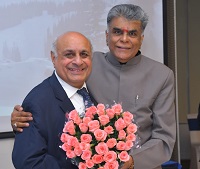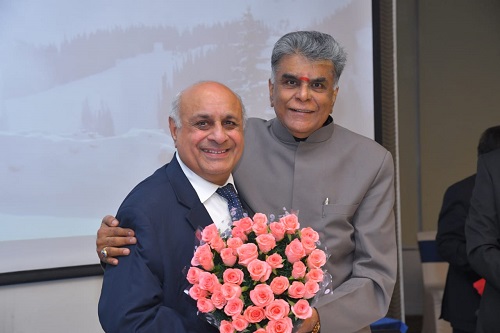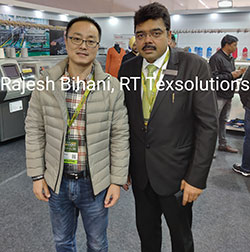FW
"Padma Shri Dr. A Sakthivel has taken over as the new chairman of the Apparel Export Promotion Council from January 6, 2020. He was elected to the Board of Directors of Apparel Export Promotion Council in the year 1982 and has served the council for almost four decades. He is also the first person in the history of AEPC, to be sworn-in for the fourth time as Chairman of the AEPC. His diligence has played a vital role in the growth of the Council and gradually led to the improvement of exports at the national level."
 Padma Shri Dr. A Sakthivel has taken over as the new chairman of the Apparel Export Promotion Council from January 6, 2020. He was elected to the Board of Directors of Apparel Export Promotion Council in the year 1982 and has served the council for almost four decades. He is also the first person in the history of AEPC, to be sworn-in for the fourth time as Chairman of the AEPC. His diligence has played a vital role in the growth of the Council and gradually led to the improvement of exports at the national level.
Padma Shri Dr. A Sakthivel has taken over as the new chairman of the Apparel Export Promotion Council from January 6, 2020. He was elected to the Board of Directors of Apparel Export Promotion Council in the year 1982 and has served the council for almost four decades. He is also the first person in the history of AEPC, to be sworn-in for the fourth time as Chairman of the AEPC. His diligence has played a vital role in the growth of the Council and gradually led to the improvement of exports at the national level.
Speaking on the occasion, Dr. A Sakthivel expressed concern over the stagnating exports and current industry scenario. He assured the members that he will work with full commitment and dedication to bring forth positive growth in apparel exports. He promised that he will put efforts to find new and potential markets for India's garment exports. He further assured that he will convince the senior officials of the Central Government to get the required incentives and benefits thereby reviving growth of the sector and overall exports.
Dr. A Sakthivel along with some exporters had established Tirupur Exporters Association in 1990 widely known as TEA. Dr. A Sakthivel was the first President of TEA and with his dynamism, he held the post continuously for a period of 27 years.
During his tenure as President of TEA, he toiled hard to develop the industry as well as Tirupur. The export turnover of Tirupur industry increased to a whopping Rs 27000 crores in 2016-17 from Rs 270 Crores in 1990.
Government of India recognised his unparalleled service to export sector specifically to apparel sector and knitting industry, creation of infrastructures such as industrial parks, ICDs and his contribution to society with regard to education, drinking water, sanitation, and drainage, etc., by honoring him with one of the country's most prestigious and esteemed Civilian Award Dr. A Sakthivel was also instrumental in so many visionary projects in Tirupur including the formation of Tirupur Export Knitwear Industrial Complex (TEKIC), Inland Container Depot (ICD), Netaji Apparel Park (NAP), International Exhibition Centre (IKF), etc. Similarly his social visionary projects include School for Children (TEA Public School), drinking water for Tirupur people and Industry through NTADCL, Fashion Knitwear Institute partnered with NIFT (NIFT-TEA Institute) etc.,
ICDs and his contribution to society with regard to education, drinking water, sanitation, and drainage, etc., by honoring him with one of the country's most prestigious and esteemed Civilian Award Dr. A Sakthivel was also instrumental in so many visionary projects in Tirupur including the formation of Tirupur Export Knitwear Industrial Complex (TEKIC), Inland Container Depot (ICD), Netaji Apparel Park (NAP), International Exhibition Centre (IKF), etc. Similarly his social visionary projects include School for Children (TEA Public School), drinking water for Tirupur people and Industry through NTADCL, Fashion Knitwear Institute partnered with NIFT (NIFT-TEA Institute) etc.,
Incorporated in 1978, AEPC is the official body of apparel exporters in India that provides invaluable assistance to Indian exporters as well as importers/ international buyers who choose India as their preferred sourcing destination for garments. In recent years AEPC has worked tirelessly in integrating the entire industry - starting at the grass the root level of training the workforce and supplying a steady stream of manpower to the industry; identifying the best countries to source machinery and other infrastructure.
Carvico has rewritten the rules of contemporary design by presenting its Lifestyle collection of fabrics for interior design at Heimtextil 2020.
The elasticity, resistance, breathability, versatility and countless options for customisation are the main features which make Carvico fabrics ideal for the interior design market.
Convertible, smart, multifunctional, and innovative, Carvico performance fabrics for furniture and design have been inspired by new trends and translate high tech performance into new shapes and styles to blend elegance and functionality with Made in Italy quality and excellence.
Original, function and innovative, Carvico Lifestyle collection features 3D textures and countless colors, strong and compact surfaces, fluid and comfortable velvets with a silky and sexy hand feel, cutting-edge, high-performance fabrics conceived to enhance shapes and volumes.
A selection of unique performance fabrics which, thanks to their bi-elasticity and resistance are ideal to cover furniture elements, to design whole rooms and complements. Extremely versatile and adaptable, handy and comfortable, easy to remove and to wash and fast drying, pilling resistant, and shape-retaining, they represent the perfect mix of quality, beauty, and functionality.
Carvico performance fabrics for the interior design market can be chosen in their standard version or the bonded, thicker and more compact one. Moreover, the addition of waterproofing membranes and treatments make them suitable also for the outdoor universe.
Beautiful, functional, high performance and with a green spirit. The Lifestyle collection includes several eco-sustainable fabrics, made of regenerated polyamide yarn from pre and post-consumer waste materials (ghost fishing nets, carpet fluff, and tulle ) which, at the end of their useful life, instead of being sent to the landfill, are recovered and regenerated through a complex physical-chemical process. This is how ECONYL® polyamide is produced to be then used for the creation of high-quality fabrics.
The National Council of Textile Organizations (NCTO), represents the full spectrum of U.S. textiles from fiber through finished sewn products, lauded Senate passage today of the U.S.-Mexico-Canada Agreement (USMCA).
Mexico and Canada being the two largest export markets for the U.S. textile and apparel industry, totaling nearly $11.5 billion for the year ending Nov. 30, 2019, according to government data.
“USMCA is an important for the textile industry,” Glas said. “The improvements it makes to the North American Free Trade Agreement (NAFTA) will only serve to generate more business for domestic producers and create more jobs and investment in the U.S.”
NCTO worked with the administration during negotiations on USMCA and secured several provisions in the trade deal including stronger rules of origin for certain textile inputs and increased U.S. customs enforcement.
U.S. textile executives are moving up to take advantage of the modifications in USMCA and some plan to build new business or expand existing business in areas such as pocketing, sewing thread and narrow elastics.
The USMCA updates and modifies the NAFTA and makes significant improvements, including, Creation of a separate chapter for textiles and apparel rules of origin with strong customs enforcement language. Stronger rules of origin for sewing thread, pocketing, narrow elastics and certain coated fabrics. Under the current NAFTA, these items can be sourced from outside the region USMCA modernizes this loophole and ensures these secondary components are originating to the region.
Fixes the Kissell Amendment Buy American loophole, ensuring that a significant amount the Department of Homeland Security spends annually on clothing and textiles for the Transportation Security Administration is spent on domestically produced products.
 “The knitting industry has grown over the past few years with over 4,500 machines making knitted shoe uppers in New Delhi today,” notes Rajesh Bihani, Managing Director, RI Texsolutions, a company engaged in manufacturing knitted shoe uppers for adults and children.
“The knitting industry has grown over the past few years with over 4,500 machines making knitted shoe uppers in New Delhi today,” notes Rajesh Bihani, Managing Director, RI Texsolutions, a company engaged in manufacturing knitted shoe uppers for adults and children.
Dismal outlook for future
However, the market is slow and the payment situation is bad. Petrol prices have shot up due to the US-Iran conflict with uncertainty prevailing in the market. “We don’t expect the situation to improve even in next six months. People making inferior products are more likely to face problems. We, at our company, always emphasise on the quality of our products. This helps us survive market upheavals,” explains Bihani.
Though the US-China trade war was expected to divert most Chinese business to India, however, it got diverted to Bangladesh, Myanmar, Vietnam. “We couldn’t take advantage of the situation as we don’t have the capacity to accommodate these orders. We also adjust our manufacturing quality according to the final cost of the product. Hence, we end up manufacturing most of our products with inferior machines,” affirms Bihani.
Government support needed to ensure market growth
As the Indian textile industry has to compete with global textile hotbeds like China, it needs the government’s support to grow. “We need to replicate the policies followed by China and Bangladesh. Though we have a market for branded products, the grassroots or local market has a bigger volume. Customers in this market are not very quality conscious. They focus more on the price of product. On the other hand, urban customers are more brand-driven and can be lured easily through publicity and shows. This scenario can change if customers start focusing on comfort, wearability and quality of product,” Bihani opines.
Another challenge the industry faces is the backdoor entry of finished garments from Bangladesh. These garments are not only of better quality but also better priced. “To compete with these garments, we need to revamp our attitude and ideologies. Right now, manufacturers are driven more by profits. They immediately switch to another business if they don’t make money in this one. They don’t wish to commit themselves to the industry. Training programs are seen more as costs rather than investment,” adds Bihani.
Dealing with competition
Offering solutions to deal with the current situation Bihani says younger entrepreneurs should involve themselves in production. “They should improve their productivity and efficiency. For this, each of their production units need to have an R&D department,” he points out.
Textile is the first industry to move out as a country develops. Indian companies too are shifting their bases to Ethiopia and Africa. “Though this is a positive sign, we are losing ground to competitors like China, which is improving its textile quality everyday. We need to buck up to stay ahead in the competition,” Bihani sums up.
"Reversing a two-decade long policy of expansion, European fashion brands are turning away from the Asian market. Decreasing consumer expenditure amid the US-China trade war is luring brands away from the Asian markets with challenges like Brexit and protests and strikes further adding to woes. Brands like Germany-based Metro and France-based Carrefour have exited their European operations in the recent past with UK-based Tesco planning to join the bandwagon. The retailer, which exited its China business in 2013 and the South Korean market in 2015, now plans to offload its Malaysia and Thailand operations."
 Reversing a two-decade long policy of expansion, European fashion brands are turning away from the Asian market. Decreasing consumer expenditure amid the US-China trade war is luring brands away from the Asian markets with challenges like Brexit and protests and strikes further adding to woes. Brands like Germany-based Metro and France-based Carrefour have exited their European operations in the recent past with UK-based Tesco planning to join the bandwagon. The retailer, which exited its China business in 2013 and the South Korean market in 2015, now plans to offload its Malaysia and Thailand operations. The sale of these operations will fetch the company over $9 billion which it plans to use to restructure its UK business which recently cut thousands of jobs and shifted to new formats including checkout-free stores amid tough competition from discounters and Brexit-related pricing pressure.
Reversing a two-decade long policy of expansion, European fashion brands are turning away from the Asian market. Decreasing consumer expenditure amid the US-China trade war is luring brands away from the Asian markets with challenges like Brexit and protests and strikes further adding to woes. Brands like Germany-based Metro and France-based Carrefour have exited their European operations in the recent past with UK-based Tesco planning to join the bandwagon. The retailer, which exited its China business in 2013 and the South Korean market in 2015, now plans to offload its Malaysia and Thailand operations. The sale of these operations will fetch the company over $9 billion which it plans to use to restructure its UK business which recently cut thousands of jobs and shifted to new formats including checkout-free stores amid tough competition from discounters and Brexit-related pricing pressure.
European retailers redirecting investments
Besides selling their Asian operations, many European retailers are also protecting their core operations by redirecting their investments. France-based Carrefour sold 80 per cent of its Chinese operations to local rival Suning.com in June 2019. The company had pulled out of the Indian market five years ago. Similarly, in November 2019, Metro announced its intention to offload China business to Wumei Technology. It now plans to sell off its Japan, India and Pakistan units. These brands are challenged by the rapid advance of online shopping which has led to the rise of numerous regional brands. Two years ago, Chinese hypermarket chain, Sun Art Retail Group, sold a 36 per cent stake to internet giant Alibaba Group Holding for $2.9 billion, boosting its digital capabilities.
cent of its Chinese operations to local rival Suning.com in June 2019. The company had pulled out of the Indian market five years ago. Similarly, in November 2019, Metro announced its intention to offload China business to Wumei Technology. It now plans to sell off its Japan, India and Pakistan units. These brands are challenged by the rapid advance of online shopping which has led to the rise of numerous regional brands. Two years ago, Chinese hypermarket chain, Sun Art Retail Group, sold a 36 per cent stake to internet giant Alibaba Group Holding for $2.9 billion, boosting its digital capabilities.
Retailers bucking the trend
However, like exceptions to every rule, few Western retailers are expanding their Asia operations with the help of local players. French retailer Auchan Retail recently boosted its stake in Sun Art. In November, Walmart unveiled plans to open about 500 stores and depots over five to seven years in China. The company’s retail outlet Sam Club managed to thrive in the Chinese market by upscaling its operations and offering foreign goods to affluent shoppers. Its competitor, Costco Wholesale also opened its first outlet in Shanghai in August 2019.
UK’s online supermarket Ocado Group took the partnership route to boost its international presence. The group collaborated with the Japanese retailer Aeon to set up robotic warehouses for online grocery sales. It believes this alliance would prove to be an invaluable experience for the company as Aeon has a deep understanding of customers’ needs and has successfully configured its technology to meet the specific challenges and opportunities of the Japanese market.
Bangladesh is interested in importing some 5000 bales of cotton from Maharashtra. Khandesh is a major cotton belt for ginners in Maharashtra and has over 100 units. Khandesh is famous for quality cotton and has the highest area of cotton in India under drip irrigation. There is a high demand for cotton from Khandesh, which can offer 29 mm, 30 mm staple cotton , 3.8+ micronier , rd 75 and trash 3-3.5 per cent quality.
Bangladesh imports at least 35 lakh bales of Indian cotton every year. The cotton season is in full swing in Khandesh. The objective in direct exports from ginners to Bangladesh is to offer better realisations to farmers in Khandesh and also to enter exports.
India is expected to produce 354 lakh bales this season. The Cotton Association of India has predicted exports of 42 lakh bales and imports of 25 lakh bales this year. In the cotton year 2019-20, India had exported 42 lakh bales of cotton and imported 32 lakh bales. The Cotton Corporation of India, under its MSP operations, is reported to have procured at least 22 lakh bales until date. Currently, market prices are around Rs 5000 per quintal on steady arrivals.
Over the next decade, new major retail brands are expected to replace legacy brands. Sustainability is a positive challenge. As consumers become savvy about the severity of fashion’s environmental footprint, they will demand more responsible production. Businesses cannot afford to ignore these trends. Retailers will be forced to be more creative with how they meet these needs, whether that means offering clothing rental services, recycling opportunities, adopting cleaner manufacturing processes or all of the above. Companies are working toward durability, material health, recyclability and traceability.
Retailers have to strengthen both online and offline channels and need to find the optimum balance between the physical and digital elements to maintain a profitable business and sustain growth. A deep design archive is not enough to secure relevancy in 2020. With more ways to discover and acquire fashion on the internet and social media, retailers must be constantly looking for windows of opportunity to connect with their consumers. Fashion brands have to constantly adapt to new consumer trends. Legacy or heritage brands must adapt or face an inevitable death. So they are maintaining their place in millennials’ closets by upgrading their iconic pieces with sustainable manufacturing, tweaking fits for the modern consumer and partnering with trend-oriented brands and retailers for unique collaborations.
India suffered a broad-based slowdown in import-export trade in 2019. Last year’s global dip in container demand, combined with domestic challenges to India’s economy, impacted the country. This is aligned closely with weak domestic demand, tight liquidity and working capital as well as a reflection of the overall cyclical weakening of the economic environment in all the main global economies. India’s year-on-year import-export trade was flat compared with global growth of 1.5 per cent.
While imports witnessed subdued growth, the overall fiscal impact was nullified by an identical contraction in exports. India’s retail, apparel and textile industries are also facing strong headwinds. The trade war, Brexit and flat economic growth in major economies are creating a challenging export market. Key competitors, such as Pakistan, Bangladesh and Vietnam, are given preferred access in northern Europe, which is India’s biggest textile market.
Bucking the trend was an 11 per cent jump in exports to Africa, led by appliances and kitchenware, vehicles and seeds, beans, cereals and flour. And reefer exports to the Mediterranean saw growth, too, primarily fuelled by meat, fish and shellfish. Exports of seafood and other reefer cargo to China also increased. Initiatives such as the Digital India policy have the potential to propel the logistics and shipping industry forward.
Indian textile exports have witnessed a bearish trend for two years in a row. Factors that have led the growth curve downward include the time taken to align to the new goods and services tax regime, the downward revision of export incentives, and the credit squeeze particularly faced by small and medium enterprises.
The Indian textile sector is one of the oldest in the Indian economy. The sector is highly diversified, catering to a wide range of segments ranging from traditional handloom products to cotton, wool and silk products and has products that vary across natural and manmade fiber, yarn and apparel. Additionally, the textile industry is closely linked and dependent on the agriculture industry in order to source raw materials such as cotton. The industry has earned a unique place in the economy due to its strong future outlook, numerous employment opportunities it has generated and the strong export numbers it has generated. The availability of large varieties of cotton fiber along with the fast-growing synthetic fiber industry has helped the industry build a strong foundation for itself. The textile industry in India has large and diversified segments that in turn enable businesses and end-consumers to choose from a wide array of products.
The Cotton Association of India (CAI) has reduced its crop estimate for the northern zone by two lakh bales from its previous month’s estimate. But there is an increase of two lakh bales in the estimate for Maharashtra as migration of the cotton crop from Maharashtra to the neighboring state is not likely to happen this year.
Domestic consumption estimated by the CAI for the entire crop year (up to September 30, 2020) is 331 lakh bales. The CAI has estimated exports for the season at 42 lakh bales, which is at the same level as estimated in the previous year. The carryover stock estimated at the end of the season is 30 lakh bales. The import figure is lower by seven lakh bales compared to that estimated for the last year. Shipment of imports from October 1, 2019, to December 31, 2019, which have reached Indian ports are estimated at 6.50 lakh bales. Cotton export shipments from October 1, 2019, to December 31, 2019, which have already been shipped are estimated at ten lakh bales.
Consumption by Indian spinning mills for three month: from October 1, 2019 to December 31, 2019, is estimated at 78 lakh bales. Cotton stock held by mills in godowns on December 31, 2019, is estimated at 30.89 lakh bales.












